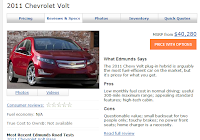 It certainly now looks like the fix was in when the Chevy Volt was named “Motor Trend Car of the Year.” Collective guffaws were heard in many quarters especially when the government motors touted the car as the virtual vehicle version of the perpetual motion machine. As Motor Trend cooed: “The Chevy Volt earns the coveted Motor Trend Magazine “Car of the Year” award” and Chevy boasted, “Powered by electricity without being tethered to electrical outlets, the Volt does everything a great car does and, according to Motor Trend, better than any other.”
It certainly now looks like the fix was in when the Chevy Volt was named “Motor Trend Car of the Year.” Collective guffaws were heard in many quarters especially when the government motors touted the car as the virtual vehicle version of the perpetual motion machine. As Motor Trend cooed: “The Chevy Volt earns the coveted Motor Trend Magazine “Car of the Year” award” and Chevy boasted, “Powered by electricity without being tethered to electrical outlets, the Volt does everything a great car does and, according to Motor Trend, better than any other.” And check out that mileage! Wow! The equivalent of 93 miles per gallon! That’s not just good, that’s AMAZING! And as it turns out, untrue. Put another way: YOUR mileage may vary. See that EPA fuel economy sticker for the hybrid Volt trumpeting 93 mpg equivalent (here)? Read the fine print. There seems to be more than a “little” deception by GM and the EPA in calculating the fuel efficiency of the Chevrolet Volt. Is this really truth in advertising?
And check out that mileage! Wow! The equivalent of 93 miles per gallon! That’s not just good, that’s AMAZING! And as it turns out, untrue. Put another way: YOUR mileage may vary. See that EPA fuel economy sticker for the hybrid Volt trumpeting 93 mpg equivalent (here)? Read the fine print. There seems to be more than a “little” deception by GM and the EPA in calculating the fuel efficiency of the Chevrolet Volt. Is this really truth in advertising? Is the EPA culpable in deceiving the public by approving this Volt mileage sticker? Is this just another example of the Administration’s effort to mandate a green political agenda through government owned General Motors and sustained by deceptive advertising?
I’m a banker and I run numbers all the time, so I decided to do a few calculations on the Volt.
 By my calculations if the range of the vehicle is 344 miles on a full tank of gas and it gets 37 mpg in gas only mode then the tank will hold 9.3 gallons. Now if the Electric/Gas MPG equivalent is 93 mpg then a 9.3 gal tank X 93 equals a range of 865 miles. Deducting the gas only range of 344 miles from 865 leaves 521 miles assigned to the electric operation only. The sticker suggests the maximum range of the electric battery before recharge is 35 miles, so dividing 521 miles by 35 miles means one has to recharge the battery ~ 14 times per tank of gas to achieve 93 mpg. Each charge takes 4 hours so for example that trip from here to LA (~870 miles) at around 60 mph will take about 14 hours of drive time and 56 hours of battery charge time if you wish to achieve the published fuel efficiency.
By my calculations if the range of the vehicle is 344 miles on a full tank of gas and it gets 37 mpg in gas only mode then the tank will hold 9.3 gallons. Now if the Electric/Gas MPG equivalent is 93 mpg then a 9.3 gal tank X 93 equals a range of 865 miles. Deducting the gas only range of 344 miles from 865 leaves 521 miles assigned to the electric operation only. The sticker suggests the maximum range of the electric battery before recharge is 35 miles, so dividing 521 miles by 35 miles means one has to recharge the battery ~ 14 times per tank of gas to achieve 93 mpg. Each charge takes 4 hours so for example that trip from here to LA (~870 miles) at around 60 mph will take about 14 hours of drive time and 56 hours of battery charge time if you wish to achieve the published fuel efficiency. But taking it one step farther, if the gas range is 344 miles and one electric charge adds an additional 35 miles, the total range on one electric/gas refill is 379 miles yielding an actual mileage efficiency based on one each gas stop and electrical charge of 40.75 mpg, far less than the published 93 mpg shown on the proposed EPA approved sticker.

 The Volt may be fuel efficient, but not all that fuel efficient and it isn’t particularly time efficient! I guess if one plans to achieve maximum fuel efficiency, one simply has to plan on sticking around home like in the good old days, say around 800 AD, when people seldom ventured down the road more than 30 miles to the neighboring village. Hanging out at the village square; very progressive! It congers of images of Vikings sacking the French villages and villagers fleeing the hordes of attackers in their fuel efficient, horse power wagons.
The Volt may be fuel efficient, but not all that fuel efficient and it isn’t particularly time efficient! I guess if one plans to achieve maximum fuel efficiency, one simply has to plan on sticking around home like in the good old days, say around 800 AD, when people seldom ventured down the road more than 30 miles to the neighboring village. Hanging out at the village square; very progressive! It congers of images of Vikings sacking the French villages and villagers fleeing the hordes of attackers in their fuel efficient, horse power wagons.Edmunds weighs in (here) with accolades and skepticism:
“… you can’t measure the Volt’s fuel economy in any standard fashion. It all depends on how you drive. Suppose you have a 20-mile round-trip commute, and you plug in your Volt every night when you get home (a full charge requires as few as 3 hours). Congratulations! Your fuel economy is infinity, because you’ll never run the battery pack down all the way. But if you have a 100-mile commute, you’ll be driving at least 60 miles a day under gasoline power, so you’ll have to refuel on a regular basis. And in an Edmunds fuel economy test of a Volt with its battery depleted, the car returned only 31.4 mpg in mixed driving. That’s far below the typical fuel economy provided by regular hybrid vehicles.
In other words: your mileage may vary. If you drive a far as Fred Flintstone you’ll be fine. If you go for the long haul you might as well stick with your sedan or ? The Chevy Volt apparently lends a new meaning to the term being “plugged in”. It seems to me, however, that for the estimated $40,000+ price tag on the Volt, one might want to spend a little less time fettered by an electrical socket. Is GM’s assertion that a Volt owner isn’t tethered accurate? No.
Pete the Banker
Pete the Banker
Tell ’em where you saw it. Http://www.victoriataft.com



